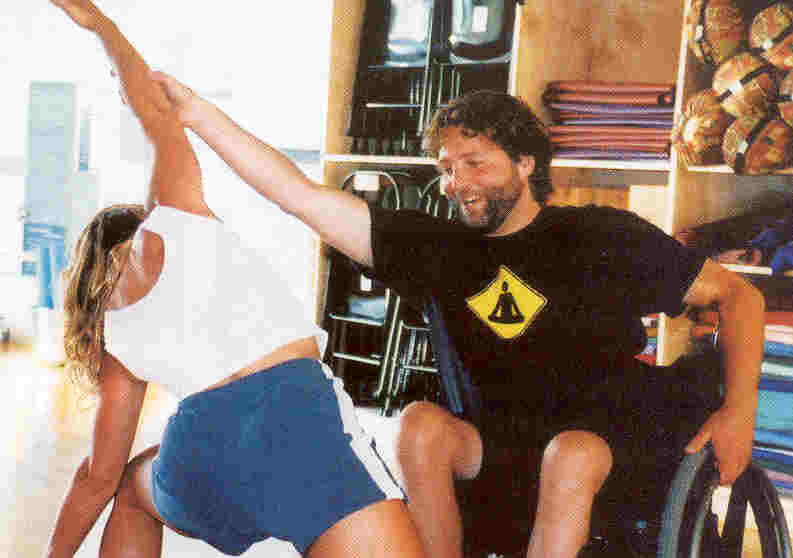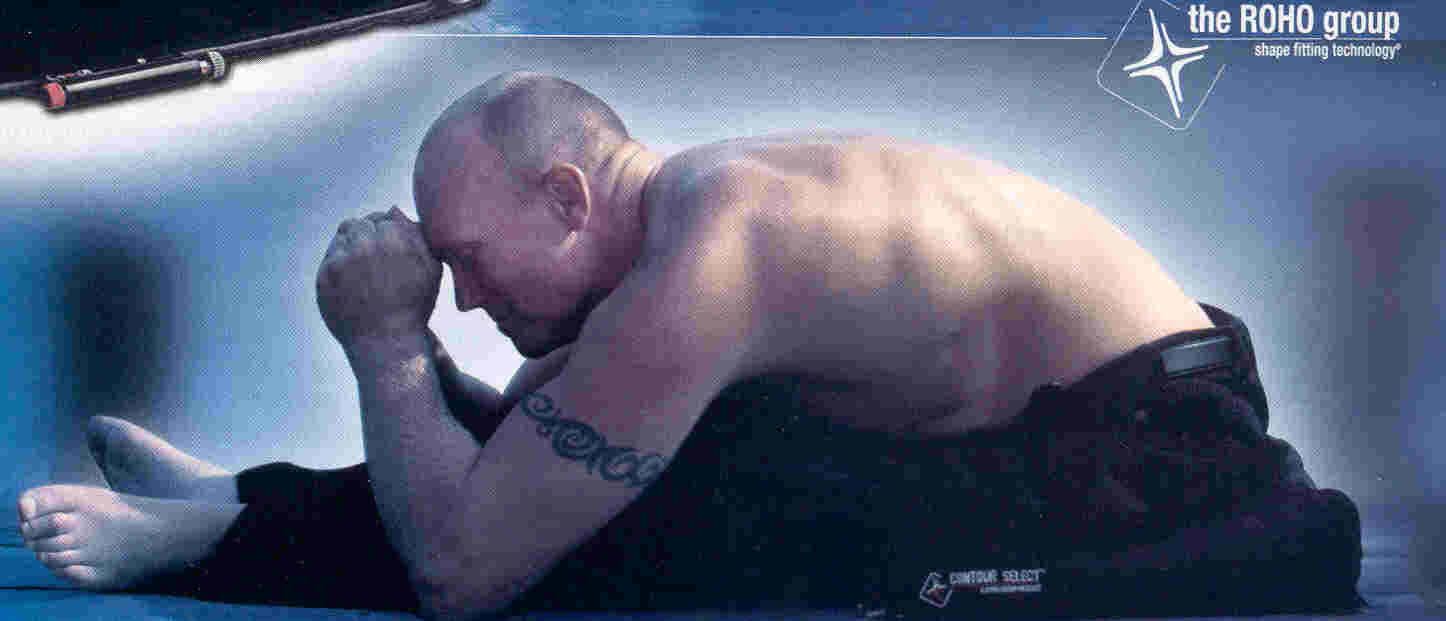|
YOGA |
|
|
LAURANCE JOHNSTON, PH.D. |
|

As a “maturing” baby
boomer sitting too much at the computer, I find my body has become
creaky. Rather than just chalking up my inflexibility to aging’s
inevitable entropy, I recently started yoga. Although once fairly
athletic, I have found the experience humbling and need a variety of
assistive devices to assume basic poses that many in the class -
especially the women - can readily do.
Reflecting on my
difficulties relative to the much greater physical limitations
associated with spinal cord injury (SCI) and wheelchair living, I
initially thought that yoga would not be a good topic to cover. My
research indicated otherwise, however. People with physical disabilities
can accrue much benefit through yoga.
As a part of this
research, I read a book written by Matthew Sanford, a 40-year-old yoga
instructor who sustained a thoracic (T4-6) injury from a 1978 roll-over
auto accident. At Minnesota’s Courage Center, Sanford teaches yoga to
others with disability, including SCI (all levels), MS, cerebral palsy,
spina bifida, head injury, and stroke. 
His book, Waking:
A Memoir of Trauma and Transcendence (2006) is one of the best books
on disability I have read. In it, he describes how learning yoga helped
him to transcend his injury through better mind-body-spirit integration,
and to energetically reconnect to paralysis-affected body parts.
After reading his
book, discussing yoga with him, and observing his class, I now believe
when adapted to the needs of individuals with physical disabilities and
with appropriate assistance, yoga is a valuable healing tool with much
to offer. According to Sanford, yoga principles do not discriminate due
to disability. Basically, the needed adaptations for disability are just
a greater expression of what I require due to middle-age inflexibility.
Unfortunately, although yoga instructors have a good idea of the
adaptations I need, relatively few appreciate the adjustments required
for significant physical disability. Therefore, one of Sanford’s
priority goals is to create and disseminate educational programs that
will better integrate yoga and disability.
Sanford emphasizes
you must have realistic expectations when starting yoga. He is, indeed,
still paralyzed after years of practice. However, he has gained a much
greater sense of a mind-body alignment, which he calls presence. Sanford
believes we define sensation too narrowly, in part, because we defer too
much to the limiting opinions of healthcare experts rather than
cultivating and listening to the voice from within. By so doing, we shut
off the subtle lines of communication that remain after injury. Yoga
helps us hear and reestablish the link to the inner voice again.
In his book, Sanford
specifically describes this re-linking: “yoga instruction rekindled a
feeling of energetic sensation within my mind-body relationship…I grew
in dimension and my entire body began whispering to me once
again, albeit in a more eloquent voice.”
Sanford believes
many possibilities other than walking exist for healing within the
mind-body relationship. Due to yoga, Sanford has become more present in
his body, senses more clarity in his spine (focal point of yogic
awareness) as he moves, is more grounded and balanced. His overall
strength and movements have an improved “bang for the buck.” Together
these results can produce many life-enhancing benefits for those with
SCI, including, for example, more efficient transfers, improved
bowel-and-bladder sensation, sexual function, etc. Finally, although
downplaying the possibility, by getting more life-force energy once
again moving through areas of paralysis-associated energy stagnation,
yoga may, indeed, cultivate an environment more conducive to
physiological regeneration.
From personal
experience, Sanford cautions yoga students with SCI to be patient and
not force progress. He states: “Every student – whether disabled or not
– must practice non-violence with his or her yoga practice.”
Unfortunately, Sanford learned the hard way; early in his practice, he
broke his leg due to his eagerness to assume an advanced lotus position.
It was a mistake he does not want to pass on.
SCI ADVANTAGE
Yoga is a
mind-body-spirit discipline whose more familiar physical poses represent
the lower rungs of a ladder leading to enhanced awareness of our greater
spiritual nature. Yoga’s Sanskrit root implies a yoking or union of the
individual to universal self. In this regard, in spite of yoga’s
physical demands, people with SCI may actually have some advantage in
climbing up the ladder.
In a crude analogy,
this ability is like hearing a whisper in a raucous bar. Because there
is so much distraction - loud conversations, ringing cell phones,
rock-and-roll music, cigarette smoke, good-looking women – it’s hard to
hear the whisper. Under yoga metaphysics, this subtle whisper represents
a higher version of who we are, and, because it is all-pervasive,
extending beyond the bar to the entire neighborhood, a connection to our
greater universe: the true source of all individual strength.
According to
Sanford, people living with SCI do not have the same gross-body
distractions, allowing them to delve deeper into the core of yoga. By
muting the sensory overload, his injury facilitated a greater connection
to the life-sustaining whisper that flows through his body, a connection
which most able-bodied students strive to achieve. In his case, Sanford
states “Meditative attention amplifies it to the point of exaggeration;
and engaging social interaction pushes it into the distant background; a
rock concert makes it disappear completely.”
Comparing his
paralysis-affected physicality to an artichoke’s outer layer, he notes:
“I received something in exchange for absorbing so much trauma at age
thirteen. I experienced a more direct contact presence of consciousness
– the heart of the artichoke. Although my life has taken much away, it
has also revealed a powerful insight.”
|
How Yoga
Helps Me
I came to Iyengar yoga twelve
years after my original injury because I missed my body. I had
reached a point where living as if I was only a floating upper
torso was no longer tolerable. I had grown weary of willfully
dragging my paralyzed body through my life. I wanted to
reconnect, to feel my entire body again in whatever way was
still possible. I figured what better way to start than a
four-thousand year old discipline that is expressly dedicated to
the integration of mind, body, and spirit.
Now, sixteen years later, I have
a vibrant sense of my whole self that I never believed was
possible. The disciplined practice of yoga has shown me the
subtle, energetic connections that exist between mind and body.
These connections are never going to make me walk again, but
they offer a sense of wholeness and vitality that inform every
aspect of my life. I can be "present" within both the paralyzed
and unparalyzed parts of my body. This realization has given me
a profound sense of inward freedom. I wish the same for
everyone.
-Matthew Sanford, January 2007 |
BODY ELECTRIC
By learning to sense
the subtle whisper through ongoing yoga practice, Sanford connects to
his paralyzed limbs without going though a hard-wired, neuronal
connection. Basically, the whisper is mediated through his body’s
electromagnetic nature. So to speak, Sanford receives information from
paralyzed limbs through radio waves rather than a telephone wire (i.e.,
neuronal connections). The transmitted information may be more subtle,
but, as receiving ability is developed, it becomes increasingly rich in
informational content – like the difference between crude Morse code and
a TV signal.
Scientists
increasingly believe that we are fundamentally electromagnetic beings.
Every molecule, cell, and organ emits electromagnetic vibrations, often
assessed through medicine’s many electronic devices (e.g., MRIs, EEGs,
etc). From a stress-related heartbeat to anxiety-generated brainwaves,
the nature of our life is a cumulative manifestation of our
electromagnetic eddies and flows and how we allow them to be influenced
by our environment.
In yoga, our
electromagnetic nature is further defined through the downloading of
life-force energy prana through vortexes called chakras.
In turn, this super-refined energy is circulated throughout the body
through thousands of energy channels, called nadis, that parallel
anatomical structures and are somewhat comparable to acupuncture
meridians.
Especially relevant
to SCI, the body’s foremost channels are the Shushmana, located
in the spine’s central column (an ene rgetic counterpart of our spinal
cord) and the Ida and Pingala channels (the energetic
equivalent of nerve plexuses that radiate out from the cord) that
crisscross through the Shushmana. The caduceus, medicine’s foremost
symbol in which two snakes intertwine around a staff, is a
representation of these life-force channels. Although beyond the
article’s scope, learning to correctly move energy through these
spinal-cord-related channels through advanced yogic practices (called
Kundalini) can mitigate SCI’s impact. rgetic counterpart of our spinal
cord) and the Ida and Pingala channels (the energetic
equivalent of nerve plexuses that radiate out from the cord) that
crisscross through the Shushmana. The caduceus, medicine’s foremost
symbol in which two snakes intertwine around a staff, is a
representation of these life-force channels. Although beyond the
article’s scope, learning to correctly move energy through these
spinal-cord-related channels through advanced yogic practices (called
Kundalini) can mitigate SCI’s impact.
Basically, like
turning up a spigot’s water pressure or taking the crimp out of the hose
that blocks the flow to the garden, yoga enhances vital-force flow
throughout the body and, in turn, the physiological functions that
support health, such as blood circulation and nervous-system
conduction.
KEY YOGA
PRACTICES
Because yoga is a
rich discipline, key practices can only be briefly highlighted, and, as
such, interested readers should consult the listed resources.
Asanas:
Yogic poses, called asanas, are key tools to obtaining benefits,
ranging from the physical to spiritual. Evolving over the millennia,
standing, sitting, bending, twisting, and reclining poses have been
developed to enhance function in every body part.
 Various
poses, especially in combination, are prescribed for diverse ailments,
including those involving heart and circulation, respiratory, digestive,
urinary, hormonal, immune, and brain and nervous systems. Various
poses, especially in combination, are prescribed for diverse ailments,
including those involving heart and circulation, respiratory, digestive,
urinary, hormonal, immune, and brain and nervous systems.
Due to his
paralysis, Sanford initially emphasized traditional sitting poses. While
practicing the Maha Mudra pose, he had an energetic breakthrough:
“As I move into this pose, something clicks or snaps into place or
becomes manifest …I suddenly feel a tangible sense of my whole body –
inside and out, paralyzed and unparalyzed. I am stunned.”
Unlike able-bodied
people who attempt to physically align themselves with the pose and then
perhaps feel the energy, Sanford teaches “backwards yoga” to students
with disability. Basically, if he feels the right energetic resonance,
he attempts to trace this energetic core back into the physical and
outward through his paralyzed body.
Pranayama
combines two words: prana, life-force energy, and ayama,
the storage or distribution of that energy. Pranayama focuses on
conscious breathing and its link to mind and body; it cultivates
life-enhancing flow of prana through the body. Because poses
remove flow-impeding barriers, pranayama’s benefits are best achieved
after the poses have been mastered. Control of inhalation, exhalation,
or breath retention influences the nervous system in different ways.
Due to its power, pranayama should be practiced under the supervision
of an experienced yoga teacher.
Meditation:
Often done in conjunction with
poses or breathing exercises, meditative practices help turn off life’s
sensory cacophony and the ensuing monkey-mind in which thoughts
constantly bounce around our consciousness. As a result, we tune into
and become more aware of our nurturing inner whisper.
Once an individual
with SCI learns the various practices by working with a good teacher,
his program should incorporate solo sessions. This allows one to tune
into the inner whisper; and, as a result, connecting to, bringing to the
surface, and better understanding deeply ingrained, subconscious
beliefs, assumptions, or issues about the injury that may inhibit
healing.
For example,
Sanford’s yoga practice triggered “body memories” that helped him
further understand forgotten circumstances surrounding his car accident.
This ultimately led him to a deeper sense of freedom within his
mind-body relationship.
IYENGAR YOGA
Sanford teaches
Iyengar yoga developed by yoga master B.K.S Iyengar. A derivation of
traditional yoga, Iyengar yoga emphasizes alignment and precision in
poses adapted to individual needs. This is facilitated through the use
of props as needed, such as wooden blocks, folded blankets, straps, etc.
Individuals with SCI who are considering yoga should attempt to find an
instructor well versed in this tradition.
CONCLUSION
Yoga has much to
offer in this modern, multitasking, sensory-overload age, especially for
individuals with SCI. By cultivating a better presence in the entire
body, yoga will cumulatively produce benefits that will greatly enhance
quality of life.
Adapted from an article appearing in the April
2007 Paraplegia News (For subscriptions, call 602-224-0500 or go
to
www.pn-magazine.com).
|
RESOURCES
Khalsa SK.
KISS Guide to Yoga. DK Publishing, 2001.
Gach MR.
Acu-Yoga. Japan Publications, 1981.
Iyengar BKS.
Yoga: The Path to Holistic Health. DK Publishing, 2001.
Raman K.
A Matter of Health: Integration of Yoga and Western Medicine for
Prevention and Cure. EastWest Books 1998.
Sanford M.
Waking: A Memoir of Trauma & Transcendence. Rodale, 2006.
Sivananda
VS. The Complete Illustrated Book of Yoga. Three Rivers
Press, 1995.
www.matthewsanford.com – Emphasizes adapted yoga for disability. |
TOP |
| |
| |
|
| |
| |
|
| |
|
|
|